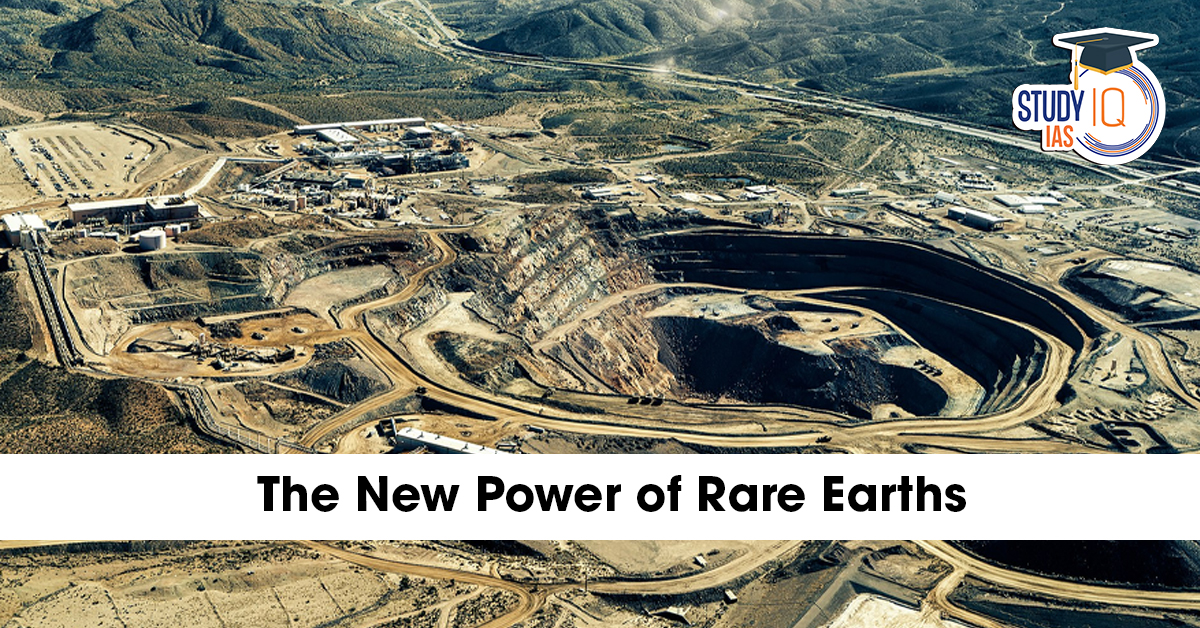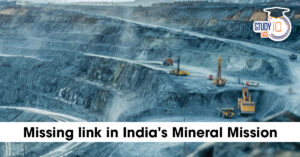Table of Contents
The global trade war between China and the United States has entered a new and decisive phase — one defined not by oil or semiconductors, but by rare earth elements (REEs).
These 17 metallic elements are the invisible foundation of modern technology — powering everything from smartphones and electric vehicles to fighter jets and satellites. But more importantly, they represent a new axis of geopolitical power.
China, which controls over 90% of global rare earth processing, has weaponised its dominance. Its latest export restrictions have reignited fears of a global supply crisis, prompting renewed strategic responses from the US, Japan, and even India.
Welcome to the age of the new power of rare earths — where control over the smallest elements may determine the future of global industries and international politics.
What Are Rare Earths?
Rare earths refer to a group of 17 metallic elements located in the periodic table between lanthanum (atomic number 57) and lutetium (71), plus scandium (21) and yttrium (39).
They possess unique physical and magnetic properties, such as:
-
High electrical conductivity
-
High melting points
-
Strong magnetic potential
Despite their name, rare earths are not actually rare — elements like cerium and neodymium are relatively abundant in the Earth’s crust. However, what makes them “rare” is that they are difficult to extract, expensive to process, and environmentally hazardous to refine.
Why Rare Earths Matter
Rare earths form the backbone of the modern technological and green revolutions. They are crucial in:
-
Smartphones and laptops (for screens and batteries)
-
Electric vehicles and wind turbines (for high-performance magnets)
-
Defense systems (for missile guidance, radar, and stealth technology)
-
Medical equipment (for MRI and radiotherapy devices)
Even a tiny amount of a rare earth element can significantly enhance performance, making them indispensable for global industries.
Examples of Key Elements and Uses
| Element | Use |
|---|---|
| Neodymium (Nd) | Permanent magnets in EVs, wind turbines, hard drives |
| Dysprosium (Dy) | High-temperature magnets for jet engines and EV motors |
| Lanthanum (La) | Hybrid batteries and camera lenses |
| Cerium (Ce) | Polishing glass, fuel additives, catalysts |
| Yttrium (Y) | Lasers and advanced ceramics |
| Gadolinium (Gd) | MRI contrast agents, magnet alloys |
China’s Monopoly: The Making of a Strategic Superpower
1. Vision from the 1980s
In 1987, Chinese leader Deng Xiaoping declared:
“The Middle East has oil, China has rare earths.”
This was not rhetoric — it was strategy. Over the next four decades, China:
-
Invested heavily in rare earth mining and refining infrastructure.
-
Allowed low-cost, high-volume production to push global competitors out.
-
Integrated rare earths into its industrial and export policy.
2. Today’s Dominance
As of 2025:
-
China controls over 60% of global rare earth mining.
-
It refines over 90% of global rare earth output.
-
It is the largest exporter of refined rare earth products and alloys.
Other countries — such as the US, Australia, Brazil, and India — have reserves but lack the technology and environmental flexibility to compete.
The Renewed China–US Rare Earth Showdown
1. The 2025 Clampdown
In October 2025, China added five new rare earths — holmium, erbium, thulium, europium, and ytterbium — to its export control list, along with magnet materials and refining technologies.
Earlier in April, it had already restricted seven others, including terbium, dysprosium, scandium, and gadolinium.
This brings the total restricted rare earths to 12 — covering the most strategically valuable elements.
2. Beijing’s Strategy
The move is part of China’s economic counterstrategy against US tariff threats. By tightening supply, Beijing increases its geopolitical leverage just ahead of key diplomatic meetings with Washington.
3. Trump’s Response
US President Donald Trump threatened 100% tariffs on Chinese exports and hinted at canceling his meeting with Xi Jinping. Though he later moderated his stance, the message was clear:
Rare earths have become a weapon of trade diplomacy.
Why Rare Earths Are the “New Oil”
Just as petroleum shaped geopolitics in the 20th century, rare earths are emerging as the defining resource of the 21st.
1. Critical for Green Energy
From EVs to wind turbines, rare earths are central to the global transition to clean energy. Without them, the dream of net-zero carbon emissions could collapse.
2. Backbone of Modern Defense
Modern weapons systems — from fighter jets to precision-guided missiles — depend on rare earth-based magnets, lasers, and radar components. Control over their supply equals control over security capabilities.
3. Economic Leverage
China’s dominance gives it enormous leverage. Restricting exports can disrupt global supply chains, raise prices, and put pressure on Western economies — a strategic tool that no other country currently possesses.
Global and Indian Response
1. United States
The US is trying to rebuild its rare earth supply chain by:
-
Reviving Mountain Pass Mine in California.
-
Investing in recycling and alternate processing technologies.
-
Planning to stockpile seabed metals under new executive orders.
2. Japan
Japan successfully diversified its sources after China imposed curbs in 2010. It now sources from Vietnam, Malaysia, and Australia, reducing reliance on Beijing.
3. India
India holds significant rare earth deposits, especially along its coasts.
-
State-owned IREL Ltd operates a processing unit with a 10,000-tonne annual capacity.
-
The Ministry of Mines recently auctioned seven seabed blocks in the Andaman Sea for exploration of polymetallic nodules rich in rare earths.
-
India plans to develop Rare Earth Theme Parks in Vizag and Bhopal to attract investment and technology partnerships.
However, India still imports around 65% of its rare earth requirements from China, underlining the need for faster domestic development.
The Road Ahead: Towards a New Rare Earth Order
The race for rare earths is reshaping geopolitics, supply chains, and industrial policy.
-
Countries are seeking “de-risking” strategies — diversifying away from Chinese dominance.
-
The formation of global rare earth alliances (involving the US, India, Japan, and Australia under the QUAD framework) is underway.
-
Recycling rare earths from e-waste and magnets could emerge as a sustainable solution.
But in the short term, China’s control remains unrivalled. With its unmatched refining capacity and state-backed mining ecosystem, Beijing sits at the centre of the world’s rare earth web.
Conclusion
The battle over rare earths is no longer about resources alone — it’s about technological sovereignty and strategic independence.
In a world racing toward electrification, artificial intelligence, and renewable energy, the real power lies not in oil rigs or coal mines but in the rare minerals beneath the earth’s surface — and in who controls them.
As China and the US continue their trade slugfest, one thing is clear:
The future of global power may well depend on the new power of rare earths.


 World Summit on Disaster Management (WSD...
World Summit on Disaster Management (WSD...
 Domestic Systemically Important Banks (D...
Domestic Systemically Important Banks (D...
 The Missing Link in India’s Critical M...
The Missing Link in India’s Critical M...

























